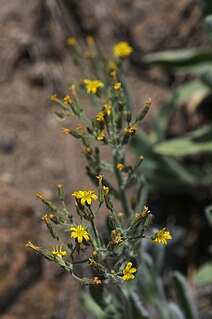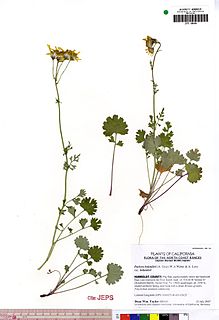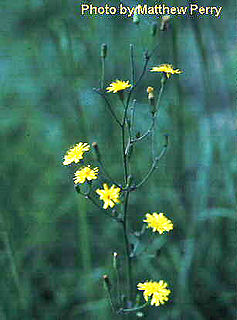
Hieracium , known by the common name hawkweed and classically as hierakion, is a genus of flowering plant in the family Asteraceae, and closely related to dandelion (Taraxacum), chicory (Cichorium), prickly lettuce (Lactuca) and sow thistle (Sonchus), which are part of the tribe Cichorieae. Hawkweeds, with their 10,000+ recorded species and subspecies, do their part to make Asteraceae the second largest family of flowering plants. Some botanists group all these species or subspecies into approximately 800 accepted species, while others prefer to accept several thousand species. Since most hawkweeds reproduce exclusively asexually by means of seeds that are genetically identical to their mother plant, clones or populations that consist of genetically identical plants are formed and some botanists prefer to accept these clones as good species whereas others try to group them into a few hundred more broadly defined species. What is here treated as the single genus Hieracium is now treated by most European experts as two different genera, Hieracium and Pilosella, with species such as Hieracium pilosella, Hieracium floribundum and Hieracium aurantiacum referred to the latter genus. Many members of the genus Pilosella reproduce both by stolons and by seeds, whereas true Hieracium species reproduce only by seeds. In Pilosella, many individual plants are capable of forming both normal sexual and asexual (apomictic) seeds, whereas individual plants of Hieracium only produce one kind of seeds. Another difference is that all species of Pilosella have leaves with smooth (entire) margins whereas most species of Hieracium have distinctly dentate to deeply cut or divided leaves.
A dry roadside dotted with small, ¾ inch red orange flowers, interspersed with very similar yellow ones, and often the white of daisies, is a good sign that you are in Hawkweed country.

Pilosella caespitosa is like several other Pilosella species and has a similar appearance to many of the hawkweeds.

Hieracium albertinum, known as western hawkweed or houndstongue hawkweed, is a species of the genus Hieracium that is very similar to Hieracium albiflorum with white flowers but differs in that the flower heads are clustered and the leaves, stems and bracts are covered in a thick layer of hairs. Standing 1 inch (3 cm) to 5 inches (13 cm) tall, it can be found blooming from June through August in forest clearings.

Pilosella horrida, known as the prickly hawkweed or shaggy hawkweed, gets its name from the long, dense, shaggy white to brown hairs (trichomes) which cover all of the plant parts of this plant species. The species is native to Oregon, California, and Nevada in the western United States.
Galium bolanderi is a species of flowering plant in the coffee family known by the common name Bolander's bedstraw. It is native to the mountains of California and southern Oregon. It is a resident of mountain forests and chaparral slopes.

Helenium bolanderi is a North American species of flowering plant in the daisy family known by the common name coastal sneezeweed. It is native to southern Oregon and northern California as far south as Mendocino County, primarily along the seacoast.

Helianthus bolanderi is a species of sunflower known by the common names Bolander's sunflower and serpentine sunflower. It is native to California and Oregon, where it grows mainly in mountainous areas, often in serpentine soils. It has been found from southwestern Oregon as well as in northern and central California as far south as Santa Cruz County, with reports of a few isolated populations in southern California.
Hieracium greenei is a species of hawkweed known by the common name Greene's hawkweed.
Allium bolanderi is a species of wild onion known by the common name Bolander's onion. It is native to northern California and southwestern Oregon, where it grows in the rocky soils of the Klamath Mountains and surrounding regions.
Kyhosia is a monotypic genus of flowering plants in the family Asteraceae containing the single species Kyhosia bolanderi, which is known by the common names Bolander's madia and kyhosia.

Packera bolanderi is a species of flowering plant in the aster family known by the common names Bolander's ragwort and seacoast ragwort. It is native to the west coast of the United States from Washington to northern California, where it grows in wet coastal forests and woodlands. There are two varieties of the species which differ slightly in morphology and habitat occupied; these varieties have been considered separate species by some authors. The var. bolanderi has thicker leaves, occurs farther south, and occupies more open types of habitat, than does var. harfordii. This plant in general is a perennial herb producing one to three stems up to half a meter tall. The basal leaves have blades up to 12 centimeters long which are divided into several lobes and borne on long, thin petioles. Leaves growing farther up the stem are smaller and have more lobes on their blades. The inflorescence contains several flower heads, each lined with dark green phyllaries. The head contains many golden yellow disc florets and generally either 8 or 13 yellow ray florets each over a centimeter long. The fruit is an achene tipped with a pappus of bristles.
Trifolium bolanderi is a species of clover known by the common names Bolander's clover and parasol clover.
Agnorhiza bolanderi is a species of flowering plant known by the common name Bolander's mule's ears. It is endemic to California, where it is known only from a narrow section of the Sierra Nevada foothills about 275 kilometers long from Shasta County to Mariposa County. It grows in chaparral and grassland habitat, usually on serpentine soils.

Hieracium traillii is a species of hawkweed known by the common name Maryland hawkweed.
Hieracium longiberbe, known by the common name longbeard hawkweed, is a rare North American plant species in the tribe Cichorieae within the family Asteraceae It has been found only in the Columbia River Gorge along the border between the states of Washington and Oregon in the northwestern United States.

Hieracium longipilum, the hairy hawkweed, is a North American plant species in the tribe Cichorieae within the family Asteraceae. It is widespread across much of central Canada and the central United States from Ontario south to Texas and Louisiana. There are old reports of the species growing in Québec, but apparently does not grow there now.
Hieracium nudicaule is a North American plant species in the tribe Cichorieae within the family Asteraceae. It grows only in the western United States, primarily in California and Oregon, though with a few populations in Washington and northern Idaho.

Hieracium paniculatum, the Allegheny hawkweed, is a North American plant species in the tribe Cichorieae within the family Asteraceae. It grows only in the eastern United States and eastern Canada, from Nova Scotia west to Ontario, Michigan, and Indiana south as far as Georgia.
Hieracium pringlei, common name Pringle's hawkweed, is a North American plant species in the tribe Cichorieae within the family Asteraceae. It is native to Mexico with additional populations in Guatemala, Arizona, and New Mexico.
Hieracium robinsonii, or Robinson's hawkweed, is a North American plant species in the tribe Cichorieae within the family Asteraceae. It is native to eastern Canada and the northeastern United States. There are reports of it formerly growing in Newfoundland, but it does not appear to grow there now.








